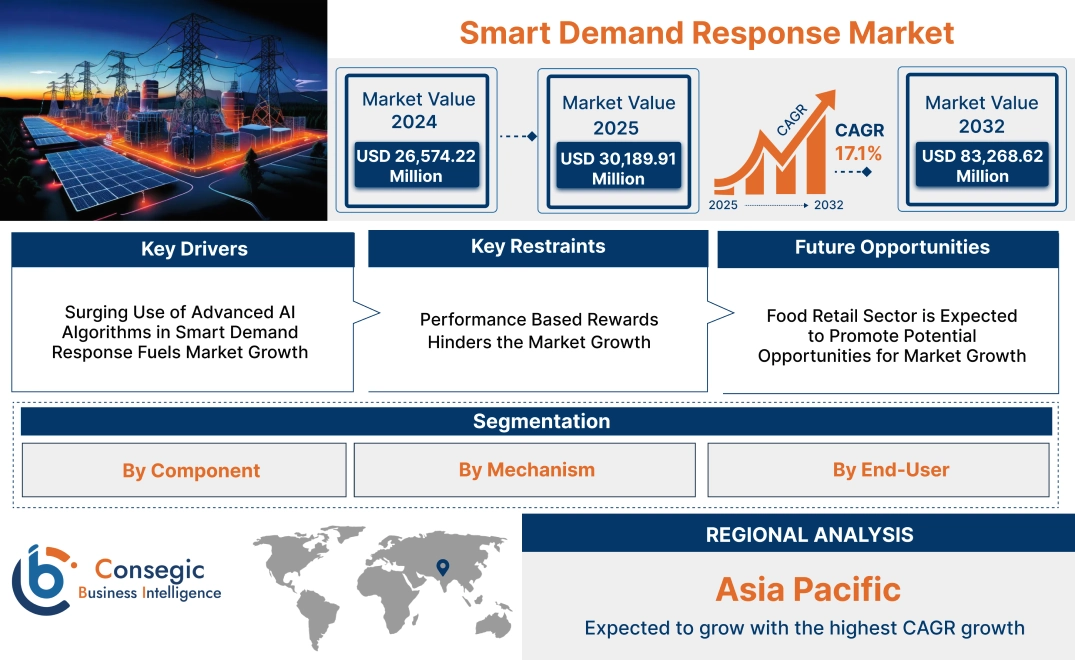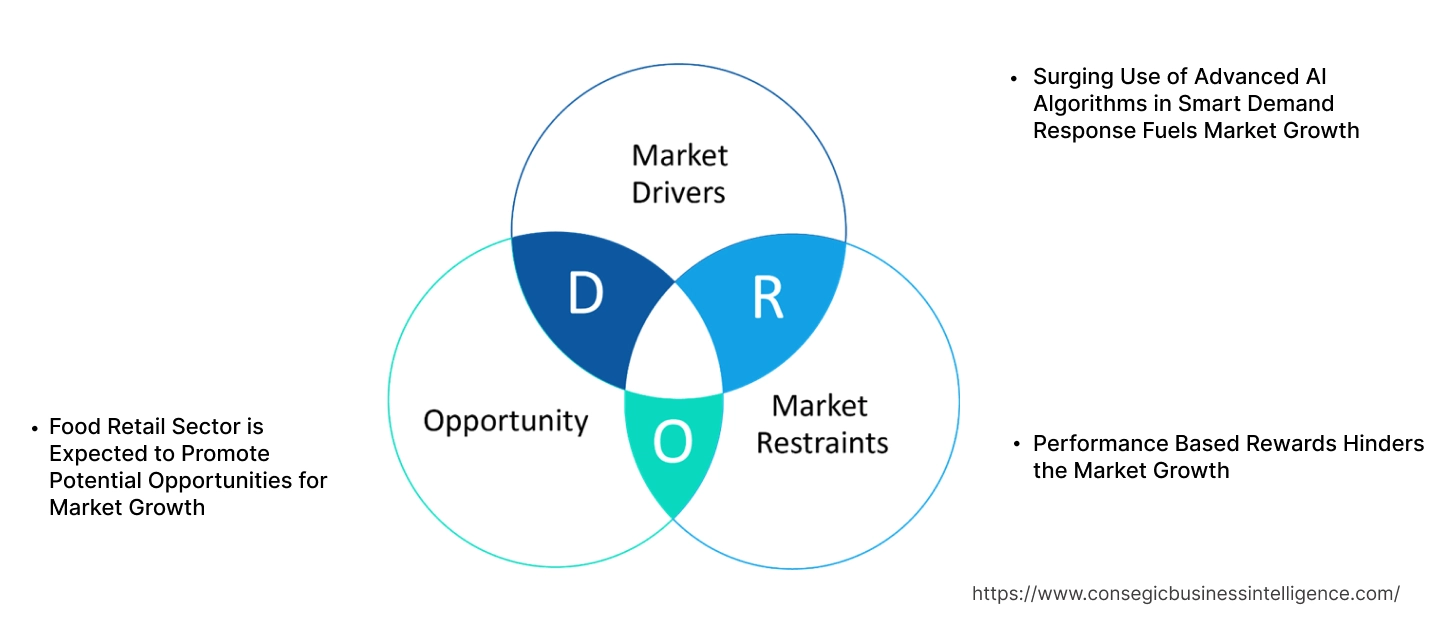- Summary
- Table Of Content
- Methodology
Smart Demand Response Market Size:
Smart Demand Response Market is estimated to reach over USD 83,268.62 Million by 2032 from a value of USD 26,574.22 Million in 2024 and is projected to grow by USD 30,189.91 Million in 2025, growing at a CAGR of 17.1% from 2025 to 2032.
Smart Demand Response Market Scope & Overview:
A smart demand response provides an opportunity for consumers in terms of response to time-based rates or other forms of financial incentives to reduce or shift electricity usage during peak periods. Moreover, the key benefits of adopting demand response program include monetizing flexible energy usage, lower energy cost, protect operation, zero emission, and more reliable electricity grid among others. Additionally, the program is majorly adopted by end users such as residential, commercial and industrial. Further, the key factor driving the smart demand response market demand is incentivizing customer behavior to optimize energy consumption.
Key Drivers:
Surging Use of Advanced AI Algorithms in Smart Demand Response Fuels Market Growth
Artificial Intelligence in transforming utility and energy sectors to help achieve net zero carbon emission goals as well as achieve sustainability goals. AI algorithms function as intelligent agents that constantly learn and evolve. AI helps in forecasting long-term energy consumption, enabling businesses to plan for future infrastructure needs and resource allocations. Additionally, the key benefits of leveraging AI into demand response is the enhancement of operational efficiency and consequent reduction in costs in turn driving the smart demand response market growth.
- For instance, in April 2024, 75F introduced smart OpenADR compliant solution which utilizes modern communication tools and AI-enabled smart devices. The aim of the devices is to systematically reduce peak energy usage in real time by powering down a portfolio of connected commercial properties.
Hence, the integration of AI into demand response program reduces cost and enhanced operational performance which in turn drives the smart demand response market growth.
Key Restraints:
Performance Based Rewards Hinders the Market Growth
The rewards associated with the demand response program is directly proportional to the analysis of performance with committed value which in turn hindering the smart demand response market expansion. Also, performance factors force the companies to hire aggregators to calculate their performance during test or event.
Therefore, performance-based rewards to the companies which have joined the program is hindering the smart demand response market expansion.
Future Opportunities :
Food Retail Sector is Expected to Promote Potential Opportunities for Market Growth
The rapidly growing focus towards digitalization, and sustainability in food retail industry is transforming industries to leverage smart demand response to achieve grid stability with financial rewards. Additionally, the supermarket utilizes demand response to enhance energy consumption in HVAC and refrigeration systems in turn boosting the smart demand response market opportunities.
- For instance, in January 2024, Danfoss partnered with Enersponse to leverage the benefits of automated demand response solution. The aim of partnership is to enhance flexibility in HVAC and refrigeration systems energy consumption by unlocking benefits for the food retail sector.
Hence, the digitalization and sustainability in food retail sector is anticipated to increase the utilization of demand response program in turn promoting prospect for smart demand response market opportunities during the forecast period.
Smart Demand Response Market Segmental Analysis :
By Component:
Based on the component, the market is segmented into hardware, software and services.
Trends in the Component:
- The trend towards adoption of IoT based demand response is expected to revolutionize energy management by providing real-time insights, automation, and enhanced control.
- The shift towards renewable energy sources due to rising energy requirements is boosting the smart demand response market trend.
Hardware accounted for the largest revenue share of 64.92% in the year 2024.
- The hardware components of smart demand response include smart grids, sensors, HVAC systems and thermostats among others.
- Moreover, demand response program leverage thermostats to help monitor and control electricity usage during peak hours in turn driving the hardware segment.
- Further, the increasing focus towards management of electricity requirement in order to reduce peak load and improve system reliability is driving the smart demand response market share.
- For instance, in March 2022, Itron, Inc. collaborated with Emerson to adopt Emerson thermostats and smart thermostats. The aim of the collaboration is to offer reliable thermostats which control about 50% of a home’s energy usage, in turn leveraging direct install demand response and distributed energy resource programs.
- Thus, the increasing focus towards management of electricity requirement is driving the hardware segment which in turn is boosting the smart demand response market share.
Services is anticipated to register the fastest CAGR during the forecast period.
- The services segment of the market bridges the gap between demand and supply in utility and energy sector by acting as intermediaries, connecting businesses and individuals with the expertise and resources required.
- Moreover, the key benefits of adopting demand response services include efficient energy usage, real-time monitoring, monitory rewards and lowering consumer energy costs among others.
- Further, the need for regular maintenance of equipment’s and software systems is driving the services segment which in turn fuels the smart demand response market size.
- For instance, in August 2024, 24 Hour Fitness leveraged Entouch demand response program into 100 locations in California and Texas as well as 39 additional locations. Additionally, with the adoption of services 24 Hour Fitness company have saved 35 MW of energy and avoided 15.1 metric tons of CO2 emissions.
- Therefore, according to the smart demand response market analysis, the need for regular maintenance of equipment’s and software systems is anticipated to boost the smart demand response market size during the forecast period.
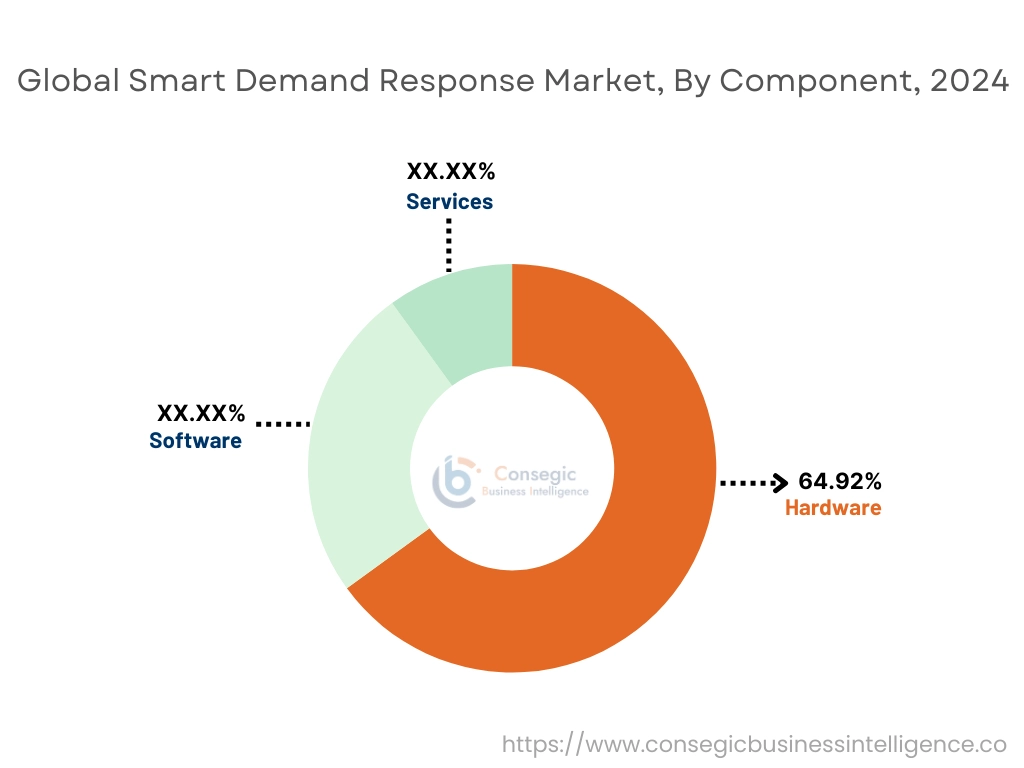
By Mechanism:
Based on the mechanism, the market is segmented into price-based and incentive-based.
Trends in the Mechanism:
- The growing commercial industry is propelling the adoption of demand response program to achieve sustainability goals as well as receive incentives which in turn drives the incentive based demand response market trend.
- The smart grids are equipped with smart meters which helps in informative decision making for companies and consumers, in turn driving the price based demand response market trend.
The price based demand response accounted for the largest revenue share in the year 2024.
- The price based demand response is also known as implicit demand response which uses price signals and tariffs to incentivize consumers to shift consumption.
- Moreover, the price based demand response provides electricity prices with varying time, real-time pricing, and others.
- Further, the price based demand response uses price signals and tariffs to incentivize consumers to shift consumption in turn driving the price based demand response segment progress.
- Thus, according to the smart demand response market analysis, the use of price signals and tariffs to incentivize consumers is driving the price based segment.
The incentive based demand response is anticipated to register the fastest CAGR during the forecast period.
- The incentive based demand response is also known as explicit demand response which helps to shift electric load, reduce grid load, enhance grid reliability and others.
- Moreover, incentive based demand response utilizes aggregators pools for direct payment.
- Further, the direct payments to consumers which shift usage at peak demand is driving the incentive based demand response segment.
- For instance, according to International Energy Agency, the government regulations are supporting demand response program is propelling adopters to achieve Net Zero Emissions by 2050.
- Therefore, as per the market analysis, the direct payment Offered by incentive based demand response is anticipated to boost the growth of segment during the forecast period.
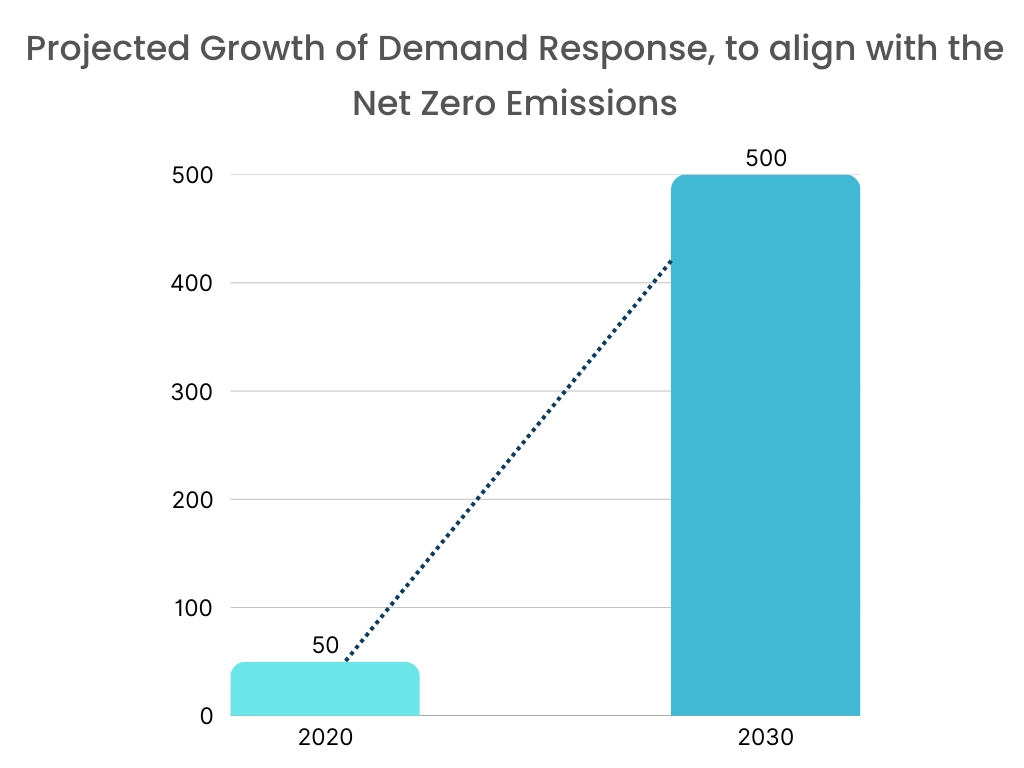
By End-User:
Based on the end-user, the market is segmented into residential, commercial, and industrial.
Trends in the End-User:
- The focus towards load flexibility is propelling the adoption of smart meters which helps in informative decision making and in turn fuels the smart demand response market trend.
- The connected commercial projects leverage modern communication tools and advanced technologies such as AI and IoT to energy usage is boosting the market trend.
Industrial accounted for the largest revenue share in the year 2024.
- Smart demand response is a strategic approach used in the industries to manage electricity consumption during peak.
- Further, the industries participate in the demand response program by shifting usage, load shedding and onsite generation among others in turn driving the smart demand response market demand.
- For instance, in May 2024, Enel partnered with Honeywell to offer demand response services to commercial & industrial facilities, institutions, and other large energy users. Additionally, the aim of partnership is to provide a turnkey building automation offering to organizations participating in demand response.
- Thus, as per the market analysis, the industries are participating by shifting usage, load shedding and other is driving the industrial end use segment progress.
Commercial is anticipated to register the fastest CAGR during the forecast period.
- Commercial segment participate in demand response programs by reducing HVAC use or major impacts such as closing the business for some part of the day in turn driving the smart demand response industry.
- Moreover, companies receive financial incentives that include cash payments or reduced rates in turn driving the adoption of smart demand response market.
- Further, the rapid adoption of automation in commercial segment is driving the growth of market by lowering infrastructure cost, lowers energy cost for customer, and reduce the frequency of load shed event.
- For instance, in April 2024, 75F launched smart OpenADR compliant solution which uses modern tools for communication to systematically reduce peak energy usage in real time by powering down a portfolio of connected commercial properties.
- Therefore, as per the market analysis, the rapid adoption of automation in commercial segment is anticipated to boost the market during the forecast period.
Regional Analysis:
The regions covered are North America, Europe, Asia Pacific, Middle East and Africa, and Latin America.
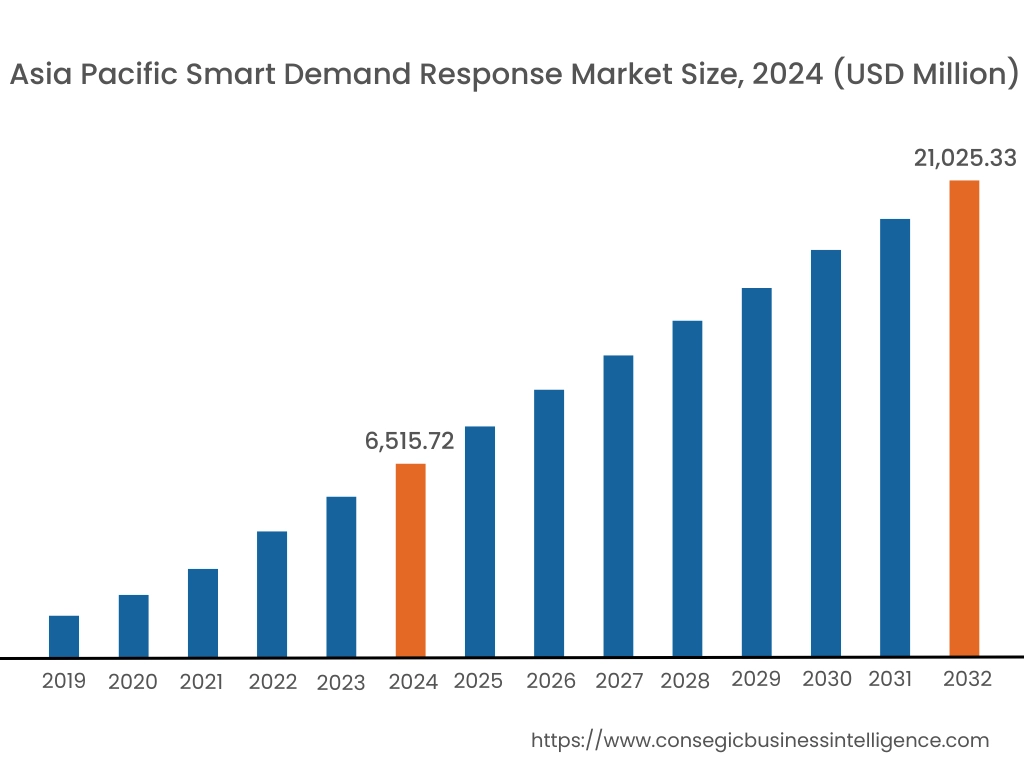
Asia Pacific region was valued at USD 6,515.72 Million in 2024. Moreover, it is projected to grow by USD 7,420.64 Million in 2025 and reach over USD 21,025.33 Million by 2032. Out of this, China accounted for the maximum revenue share of 29.4%. The rapidly growing urbanization and infrastructure development is driving the market progress. Furthermore, factors including rising adoption of smart technologies for reducing electric consumption is projected to drive the market progress in Asia Pacific region during the forecast period.
- For instance, in January 2024, Samsung launched Flex Connect, which is a demand response program utilizing SmartThings to automate thermostats, plugs, air conditioners and others. Also, the users receive Samsung rewards points in return.
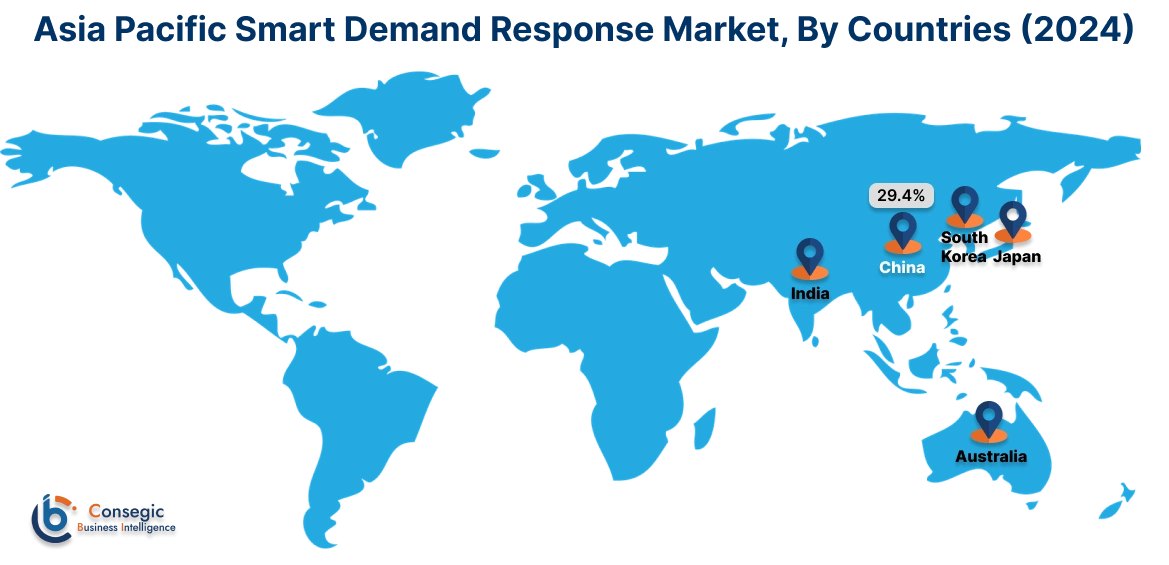
North America is estimated to reach over USD 30,809.39 Million by 2032 from a value of USD 9,897.22 Million in 2024 and is projected to grow by USD 11,237.70 Million in 2025. The North American region's growing adoption of smart grids and smart meters offer lucrative growth prospects for the market. Additionally, the increasing focus towards achieving net zero carbon emission and sustainability goals is boosting market progress.
- For instance, in September 2023, PG&E partnered with Uplight to achieve a milestone of surpassing 100,000 enrollments for smart thermostat demand response program.
The regional evaluation depicts that the increasing renewable energy source is driving the market in Europe. Additionally, the primary factor driving the market in the Middle East and African region is smart city initiative and digital transformation. Further, the rising focus towards power system modernization and effective utilization of distributed energy resources is paving the way for the progress of market in Latin America region.
Top Key Players and Market Share Insights:
The global smart demand response market is highly competitive with major players providing demand response to the national and international markets. Key players are adopting several strategies in research and development (R&D), product innovation, and end-user launches to hold a strong position in the smart demand response industry. Key players in the smart demand response market include-
- Siemens (Germany)
- Landis+Gyr (Switzerland)
- Comverge, Inc. (USA)
- Johnsons Control Inc. (USA)
- Honeywell International, Inc. (USA)
- Tucson Electric Power (USA)
- NRG Energy, Inc. (USA)
- 75F (USA)
- Eaton (USA)
- Itron Inc. (USA)
Recent Industry Developments :
Launches:
- In May 2024, Ecobee updated the grid resiliency program to protect customers from power outages caused by extreme weather. The update leverages Ecobee smart thermostat and Ecobee mobile app for prior informing users about the risk of an outage.
- In March 024, Leap launched new platform capabilities for virtual power plant platform to leverage distributed energy resource technology and electric grid. Also, the dashboard helps to integrate DERs into demand response and other grid services programs.
- In March 2024, DemandQ launched real-time demand hub, is designed for suppliers, demand response aggregators and others to automatically execute demand response and economic demand dispatch programs.
Partnerships & Collaborations:
- In January 2025, Rocky Mountain Power partnered with Torus to leverage Torus Nova technology for exploration of 70 megawatts of demand response capacity.
- In December 2024, Tata Consultancy Services partnered with Landis+Gyr to provide energy efficiency solutions. The aim of the partnership is to help achieve sustainability goals, reduce carbon emissions and improve operational efficiency.
Smart Demand Response Market Report Insights :
| Report Attributes | Report Details |
| Study Timeline | 2019-2032 |
| Market Size in 2032 | USD 83,268.62 Million |
| CAGR (2025-2032) | 17.1% |
| By Component |
|
| By Mechanism |
|
| By End-User |
|
| By Region |
|
| Key Players |
|
| North America | U.S. Canada Mexico |
| Europe | U.K. Germany France Spain Italy Russia Benelux Rest of Europe |
| APAC | China South Korea Japan India Australia ASEAN Rest of Asia-Pacific |
| Middle East and Africa | GCC Turkey South Africa Rest of MEA |
| LATAM | Brazil Argentina Chile Rest of LATAM |
| Report Coverage |
|
Key Questions Answered in the Report
How big is the smart demand response market? +
The smart demand response Market is estimated to reach over USD 83,268.62 Million by 2032 from a value of USD 26,574.22 Million in 2024 and is projected to grow by USD 30,189.91 Million in 2025, growing at a CAGR of 17.1% from 2025 to 2032.
What specific segmentation details are covered in the smart demand response report? +
The smart demand response report includes specific segmentation details for component, mechanism, end-user, and regions.
Which is the fastest segment anticipated to impact the market growth? +
In the smart demand response market, the services segment is the fastest growing segment during the forecast period due to need for regular maintenance of equipment’s and software systems.
Who are the major players in the smart demand response market? +
The key participants in the smart demand response market are Siemens (Germany), Landis+Gyr (Switzerland), Tucson Electric Power (USA), NRG Energy, Inc. (USA), 75F (USA), Eaton (USA), Itron Inc. (USA), Comverge, Inc. (USA), Johnsons Control Inc. (USA), Honeywell International, Inc. (USA) and others.
What are the key trends in the smart demand response market? +
The smart demand response market is being shaped by several key trends including trend towards adoption of IoT based demand response is expected to revolutionize energy management by providing real-time insights, automation, and enhanced control and other are the key trends driving the market.
